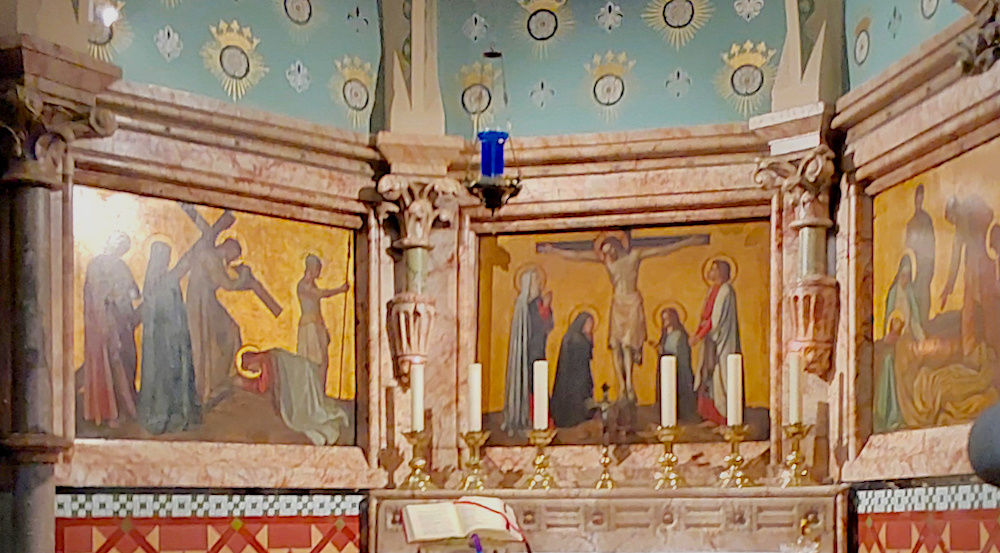Nathaniel Westlake contributed a great deal of painted decoration to the Church of St Francis of Assisi in Notting Hill. The exterior of the church was designed by Henry Clutton, but the interior was the work of J.F. Bentley. Bentley's daughter and biographer Winefride de l'Hôpital describes how he and Westlake met, and how their working relationship developed after they first became acquainted through the sculptor, Theodore Phyffers:
At his [Phyffers'] studio in Pimlico, where students of good craftsmanship were wont to meet, Bentley first made the acquaintance of N.H.J. Westlake, F.S.A., in the spring of 1859. Then began a connection and a friendship enduring for nearly a quarter of a century between the architect and the afterwards well-known stained glass designer and writer on ecclesiastical decoration, etc. Westlake had a share in one of his first commissions, the altar of St. John at St. Francis' Church, Notting Hill, for which he painted the panels; and so the connection continued for many years. Westlake did the painting for all his altars; while Bentley made the designs for stained glass which Westlake cartooned and executed. It was through Bentley too that Nat Westlake met Lavers, the glass painter, and went to work for his firm (then Lavers & Barraud) in Endell Street; in which later he became a partner and finally the sole proprietor. [353-54]
The Altar dedicated to St John

The altar of St John identified as one of Bentley's earliest commissions, has a reredos with a "moulded cusped frame of alabaster enclosing a painted representation of St. John giving communion to the Blessed Virgin" (de l'Hôpital 373). Westlake's painting here and on the front of the altar is described admiringly in the same source, and in some detail:
The diaper on the gold background is an arrangement of eagles with intermediate stars, while on the right of the Blessed Virgin is the crowned lily and on the left of St. John the palm. The nimbi are also symbolically decorated. In the frontal are two pictures on gold backgrounds representing St. John and his prototype Daniel; in the former are introduced the eagle and palm, in the latter the lions. [de l'Hôpital 373]
The closing comment here by de l'Hôpital is also very helpful: "These subjects, treated in a purely decorative manner, and therefore kept flat in colour and outlined with a strong black line, were painted by Mr. N.H.J. Westlake, the first of a long series of works executed in collaboration with Bentley" (373). This explains Westlake's artistic approach to his church paintings, and indicates that the work marked an important milestone for him, as well as for the architect.
The Altarpiece of the Lady Chapel Altar

As for the altar in the Lady Chapel at St Francis of Assisi, de l'Hôpital describes the "frames of moulded alabaster enclosing the three subjects of the reredos.... (centrally) the Crucifixion, (left) the carrying of the Cross, (right) the descent from the Cross" (375).
The High Altar, which is remarkable for its mosaic work and different marbles, also has elements of painted artwork, this time on its frontal: the body of the crucified Christ lying against a golden background, and a richly ornamented representation of the Sacred Heartvery elaborate se are just two examples of Westlake's work in the church, which included the painted decoration the Stations of the Cross on the walls.
Link to Related Material
- St Francis of Assisi, Notting Hill, London (shows these and other examples of Westlake's work in situ, including some of the Stations of the Cross)
- The High Altar, featuring the sculptural work by Thomas Earp and his men, as well as painted decoration by Westlake
Text and formatting by Jacqueline Banerjee. These images may be used without prior permission for any scholarly or educational purpose as long as you (1) credit the photographer and (2) link your document to this URL in a web document or cite the Victorian Web in a print one.
Bibliography
de l'Hôpital, Winefride. Westminster Cathedral and Its Architect, Volume II. London: Hutchinson, 1919. Internet Archive, from a copy in the University of California Libraries. Web. 11 May 2024.
Created 9 November 2016